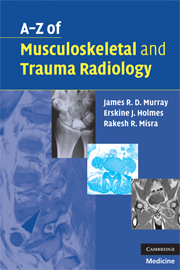Book contents
- Frontmatter
- Contents
- Acknowledgements
- Preface
- List of abbreviations
- Section I Musculoskeletal radiology
- Achilles tendonopathy/rupture
- Aneurysmal bone cysts
- Ankylosing spondylitis
- Avascular necrosis – osteonecrosis
- Femoral-head osteonecrosis
- Kienböck's disease
- Back pain – including spondylolisthesis/spondylolysis
- Bone cysts
- Bone infarcts (medullary)
- Charcot joint (neuropathic joint)
- Complex regional-pain syndrome
- Crystal deposition disorders
- Developmental dysplasia of the hip (DDH)
- Discitis and vertebral osteomyelitis
- Disc prolapse – PID – ‘slipped discs’ and sciatica
- Diffuse idiopathic skeletal hyperostosis (DISH)
- Dysplasia – developmental disorders
- Enthesopathy
- Gout
- Haemophilia
- Hyperparathyroidism
- Hypertrophic pulmonary osteoarthropathy
- Irritable hip/transient synovitis
- Juvenile idiopathic arthritis
- Langerhans-cell histiocytosis
- Lymphoma of bone
- Metastases to bone
- Multiple myeloma
- Myositis ossificans
- Non-accidental injury
- Osteoarthrosis – osteoarthritis
- Osteochondroses
- Osteomyelitis (acute)
- Osteoporosis
- Paget's disease
- Perthes disease
- Pigmented villonodular synovitis (PVNS)
- Psoriatic arthropathy
- Renal osteodystrophy (including osteomalacia)
- Rheumatoid arthritis
- Rickets
- Rotator-cuff disease
- Scoliosis
- Scheuermann's disease
- Septic arthritis – native and prosthetic joints
- Sickle-cell anaemia
- Slipped upper femoral epiphysis (SUFE)
- Tendinopathy – tendonitis
- Tuberculosis
- Tumours of bone (benign and malignant)
- Section II Trauma radiology
Septic arthritis – native and prosthetic joints
from Section I - Musculoskeletal radiology
Published online by Cambridge University Press: 22 August 2009
- Frontmatter
- Contents
- Acknowledgements
- Preface
- List of abbreviations
- Section I Musculoskeletal radiology
- Achilles tendonopathy/rupture
- Aneurysmal bone cysts
- Ankylosing spondylitis
- Avascular necrosis – osteonecrosis
- Femoral-head osteonecrosis
- Kienböck's disease
- Back pain – including spondylolisthesis/spondylolysis
- Bone cysts
- Bone infarcts (medullary)
- Charcot joint (neuropathic joint)
- Complex regional-pain syndrome
- Crystal deposition disorders
- Developmental dysplasia of the hip (DDH)
- Discitis and vertebral osteomyelitis
- Disc prolapse – PID – ‘slipped discs’ and sciatica
- Diffuse idiopathic skeletal hyperostosis (DISH)
- Dysplasia – developmental disorders
- Enthesopathy
- Gout
- Haemophilia
- Hyperparathyroidism
- Hypertrophic pulmonary osteoarthropathy
- Irritable hip/transient synovitis
- Juvenile idiopathic arthritis
- Langerhans-cell histiocytosis
- Lymphoma of bone
- Metastases to bone
- Multiple myeloma
- Myositis ossificans
- Non-accidental injury
- Osteoarthrosis – osteoarthritis
- Osteochondroses
- Osteomyelitis (acute)
- Osteoporosis
- Paget's disease
- Perthes disease
- Pigmented villonodular synovitis (PVNS)
- Psoriatic arthropathy
- Renal osteodystrophy (including osteomalacia)
- Rheumatoid arthritis
- Rickets
- Rotator-cuff disease
- Scoliosis
- Scheuermann's disease
- Septic arthritis – native and prosthetic joints
- Sickle-cell anaemia
- Slipped upper femoral epiphysis (SUFE)
- Tendinopathy – tendonitis
- Tuberculosis
- Tumours of bone (benign and malignant)
- Section II Trauma radiology
Summary
Characteristics
Acute infection of a joint – usually monoarthritis, but may be at multiple sites.
Usually bacterial; Staphylococcus being the most common infective group of organisms.
Affects all ages (more common in young/old).
Watch for immunodeficiency, e.g. steroids/chemotherapy, diabetes, HIV.
Lower extremity (75%); over pressure points in diabetic foot.
May originate from osteomyelitis or result in osteomyelitis.
Clinical features
History of antecedent illness, recent surgery including dental work.
Systemic illness – patients usually febrile and unwell.
Hot, swollen, painful joint.
Usually severely restricted movement and commonly held in a position as to reduce the pressure within the joint, e.g. in a septic knee, the patients hold the knee in approximately 10°–15° flexion to relax the posterior capsule.
Raised WBC (neutrophils), CRP and ESR. May have positive blood cultures.
Radiological features
Initial radiographs often normal.
Soft-tissue swelling secondary to local hyperaemia and oedema.
Joint distension ± subluxation of hip and humerus in children.
Joint-space narrowing indicates rapid development of destruction of articular cartilage.
Small erosions in articular cortex, loss of cortical outline and reactive bone sclerosis seen after about 8 to 10 days.
Implants: lucency around the implant, subsidence and bone loss.
Management
Patient resuscitation if shocked.
Careful aseptic aspiration of the joint – send for urgent Gram stain, culture and sensitivity, and crystals.
If patient unwell, start empirical antibiotics (now specimen taken), but if patient systemically stable await microscopy.
If positive for organisms, then the joint is likely to need debridement (open or arthroscopic), but repeated aspiration and prolonged antibiotics have been used as a successful treatment of septic arthritis by rheumatologists for some time.
With arthroplasty, debridement is unlikely to succeed unless the infection is ‘early’ – between 2 and 6 weeks after implantation. Otherwise a formal (one- or) two-stage revision will be needed.
[…]
- Type
- Chapter
- Information
- A-Z of Musculoskeletal and Trauma Radiology , pp. 139 - 142Publisher: Cambridge University PressPrint publication year: 2008



